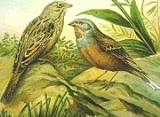
Cretzschmar's Bunting
Encyclopedia
The Cretzschmar's Bunting, Emberiza caesia, is a passerine
bird
in the bunting
family Emberizidae, a group now separated by most modern authors from the finch
es, Fringillidae.
It breeds in Greece
, Turkey
, Cyprus
and the coastal countries along the eastern edge of the Mediterranean. It is migratory
, wintering in the Sudan
. It is a very rare wanderer to western Europe
.
Cretzschmar's Bunting breeds on sunny open hillsides, with some bushes. It is mainly coastal or insular, and often breeds at lower levels than the closely related Ortolan Bunting
where both occur. It lays four to six eggs in a ground nest. Its natural food consists of insects when feeding young, and otherwise seeds.
This bird is smaller than Ortolan. The breeding male has a grey head with orange moustaches. The upperparts are brown and heavily streaked, except on the rump, and the underparts are rusty orange. The stout bill is pink.
Females and young birds have a weaker head pattern, and are more similar to Ortolans. They can be distinguished by the warm brown rump and white eye-ring.
This bird was named after the German physician Philipp Jakob Cretzschmar
.
Passerine
A passerine is a bird of the order Passeriformes, which includes more than half of all bird species. Sometimes known as perching birds or, less accurately, as songbirds, the passerines form one of the most diverse terrestrial vertebrate orders: with over 5,000 identified species, it has roughly...
bird
Bird
Birds are feathered, winged, bipedal, endothermic , egg-laying, vertebrate animals. Around 10,000 living species and 188 families makes them the most speciose class of tetrapod vertebrates. They inhabit ecosystems across the globe, from the Arctic to the Antarctic. Extant birds range in size from...
in the bunting
Bunting (bird)
Buntings are a group of Eurasian and African passerine birds of the family Emberizidae.They are seed-eating birds with stubby, conical bills, and are the Old World equivalents of the species known in North America as sparrows...
family Emberizidae, a group now separated by most modern authors from the finch
Finch
The true finches are passerine birds in the family Fringillidae. They are predominantly seed-eating songbirds. Most are native to the Northern Hemisphere, but one subfamily is endemic to the Neotropics, one to the Hawaiian Islands, and one subfamily – monotypic at genus level – is found...
es, Fringillidae.
It breeds in Greece
Greece
Greece , officially the Hellenic Republic , and historically Hellas or the Republic of Greece in English, is a country in southeastern Europe....
, Turkey
Turkey
Turkey , known officially as the Republic of Turkey , is a Eurasian country located in Western Asia and in East Thrace in Southeastern Europe...
, Cyprus
Cyprus
Cyprus , officially the Republic of Cyprus , is a Eurasian island country, member of the European Union, in the Eastern Mediterranean, east of Greece, south of Turkey, west of Syria and north of Egypt. It is the third largest island in the Mediterranean Sea.The earliest known human activity on the...
and the coastal countries along the eastern edge of the Mediterranean. It is migratory
Bird migration
Bird migration is the regular seasonal journey undertaken by many species of birds. Bird movements include those made in response to changes in food availability, habitat or weather. Sometimes, journeys are not termed "true migration" because they are irregular or in only one direction...
, wintering in the Sudan
Sudan
Sudan , officially the Republic of the Sudan , is a country in North Africa, sometimes considered part of the Middle East politically. It is bordered by Egypt to the north, the Red Sea to the northeast, Eritrea and Ethiopia to the east, South Sudan to the south, the Central African Republic to the...
. It is a very rare wanderer to western Europe
Europe
Europe is, by convention, one of the world's seven continents. Comprising the westernmost peninsula of Eurasia, Europe is generally 'divided' from Asia to its east by the watershed divides of the Ural and Caucasus Mountains, the Ural River, the Caspian and Black Seas, and the waterways connecting...
.
Cretzschmar's Bunting breeds on sunny open hillsides, with some bushes. It is mainly coastal or insular, and often breeds at lower levels than the closely related Ortolan Bunting
Ortolan Bunting
The Ortolan, or Ortolan Bunting, Emberiza hortulana, is a bird in the bunting family Emberizidae, a passerine family now separated by most modern authors from the finches, Fringillidae...
where both occur. It lays four to six eggs in a ground nest. Its natural food consists of insects when feeding young, and otherwise seeds.
This bird is smaller than Ortolan. The breeding male has a grey head with orange moustaches. The upperparts are brown and heavily streaked, except on the rump, and the underparts are rusty orange. The stout bill is pink.
Females and young birds have a weaker head pattern, and are more similar to Ortolans. They can be distinguished by the warm brown rump and white eye-ring.
This bird was named after the German physician Philipp Jakob Cretzschmar
Philipp Jakob Cretzschmar
Philipp Jakob Cretzschmar was a German physician.Cretzschmar was born at Sulzbach and studied medicine at the University of Würzburg. He taught anatomy and zoology at the Senckenberg Medical Institute of Frankfurt....
.

